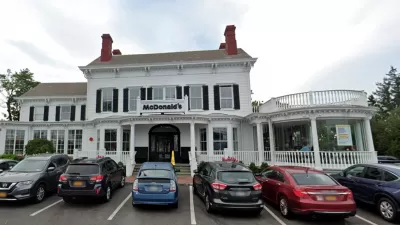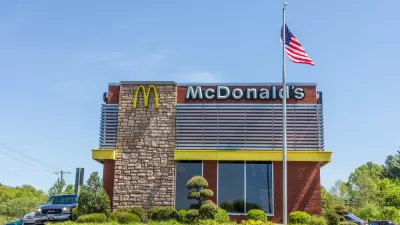In the 1980s and 90s, a pair of accomplished architecture firms were asked to design restaurants for the world's most famous, and formulaic, fast food chain. See what happened when the avant garde rethought the golden arches.
"Ever since the late 1960s, when McDonald’s abandoned its iconic, modernist-inspired golden-arched buildings in favor of a separate, golden-arched sign and a decidedly less exciting mansard-roofed structure, it has been rare to mention the words 'McDonald’s' and 'architecture' in the same sentence," writes Jimmy Stamp. "Rare, but not unheard of, as a few notable architects designed some of the franchise’s more exceptional establishments."
One such establishment was located in Berwyn, Illinois, where architecture firm SITE was asked to design "something daring". "At the time, SITE was known for bringing a surprising sculptural sensibility to the Best Products retail stores and they brought that same subversive approach to their work for McDonald’s, identifying the standard ingredients, as it were, of a typical franchise –mansard roof, brick exterior, Colonial-style windows, golden arches– and then re-presenting them in a new way," explains Stamp.
"Another significant McDonald’s was built in the 1990s by renowned architects Robert Venturi and Denise Scott Brown in Buena Vista, Florida," he continues. "Venturi and Scott Brown describe their design as 'a classic example of American commercial architecture defined by signage and symbolism within a roadside context whose conventional order we tweaked, in cooperation with McDonald’s.'”
FULL STORY: Would You Like Arches With That? When Famous Architects Design McDonalds

Maui's Vacation Rental Debate Turns Ugly
Verbal attacks, misinformation campaigns and fistfights plague a high-stakes debate to convert thousands of vacation rentals into long-term housing.

Planetizen Federal Action Tracker
A weekly monitor of how Trump’s orders and actions are impacting planners and planning in America.

In Urban Planning, AI Prompting Could be the New Design Thinking
Creativity has long been key to great urban design. What if we see AI as our new creative partner?

King County Supportive Housing Program Offers Hope for Unhoused Residents
The county is taking a ‘Housing First’ approach that prioritizes getting people into housing, then offering wraparound supportive services.

Researchers Use AI to Get Clearer Picture of US Housing
Analysts are using artificial intelligence to supercharge their research by allowing them to comb through data faster. Though these AI tools can be error prone, they save time and housing researchers are optimistic about the future.

Making Shared Micromobility More Inclusive
Cities and shared mobility system operators can do more to include people with disabilities in planning and operations, per a new report.
Urban Design for Planners 1: Software Tools
This six-course series explores essential urban design concepts using open source software and equips planners with the tools they need to participate fully in the urban design process.
Planning for Universal Design
Learn the tools for implementing Universal Design in planning regulations.
planning NEXT
Appalachian Highlands Housing Partners
Mpact (founded as Rail~Volution)
City of Camden Redevelopment Agency
City of Astoria
City of Portland
City of Laramie





























